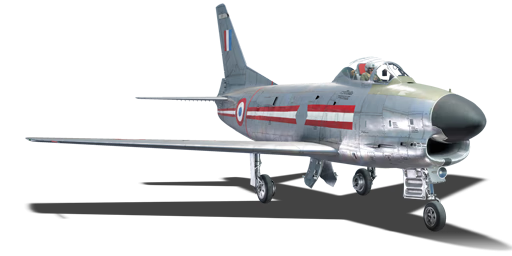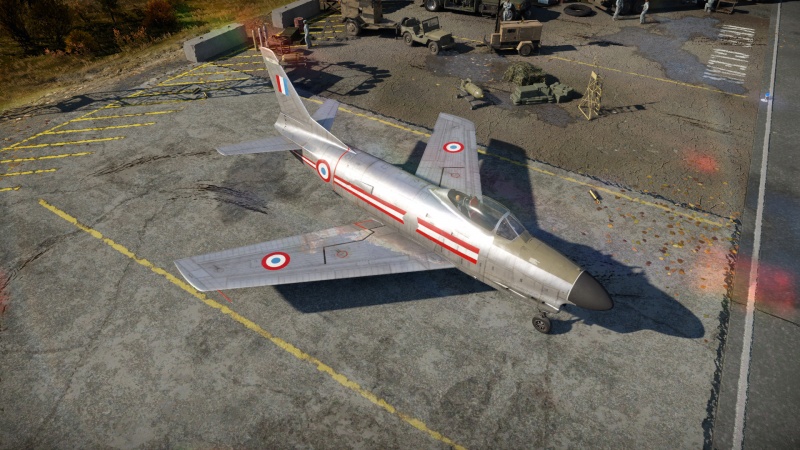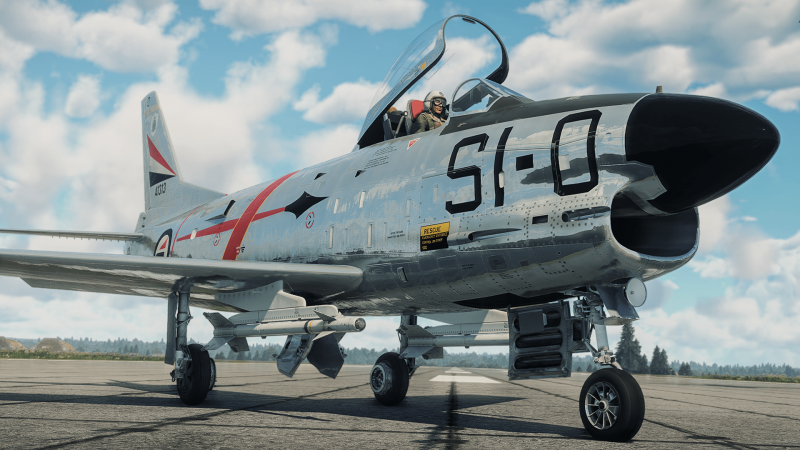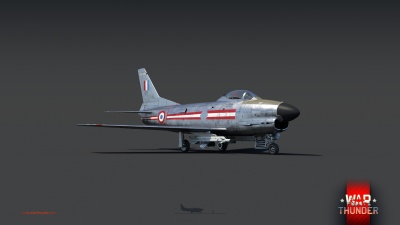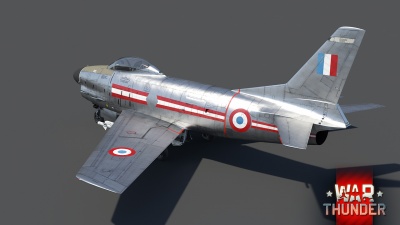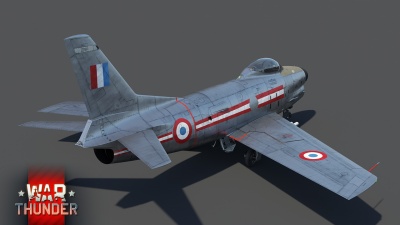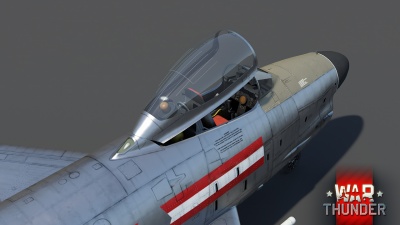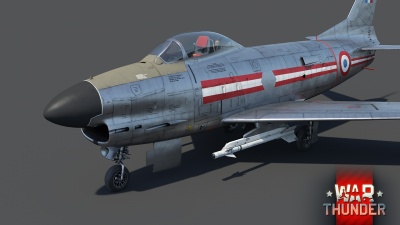Difference between revisions of "F-86K (France)"
(→Flight performance) |
Colok76286 (talk | contribs) (Undo revision 194932 by U149428818 (talk)) |
||
| (16 intermediate revisions by 10 users not shown) | |||
| Line 1: | Line 1: | ||
| − | |||
{{About | {{About | ||
| − | |about = | + | |about = jet fighter '''{{PAGENAME}}''' |
|usage = other versions | |usage = other versions | ||
|link = F-86 (Family) | |link = F-86 (Family) | ||
| + | }} | ||
| + | {{Specs-Card | ||
| + | |code=f-86k_late | ||
| + | |images={{Specs-Card-Image|GarageImage_{{PAGENAME}}.jpg|ArtImage_{{PAGENAME}}.png}} | ||
}} | }} | ||
== Description == | == Description == | ||
<!-- ''In the description, the first part should be about the history of and the creation and combat usage of the aircraft, as well as its key features. In the second part, tell the reader about the aircraft in the game. Insert a screenshot of the vehicle, so that if the novice player does not remember the vehicle by name, he will immediately understand what kind of vehicle the article is talking about.'' --> | <!-- ''In the description, the first part should be about the history of and the creation and combat usage of the aircraft, as well as its key features. In the second part, tell the reader about the aircraft in the game. Insert a screenshot of the vehicle, so that if the novice player does not remember the vehicle by name, he will immediately understand what kind of vehicle the article is talking about.'' --> | ||
| − | [[ | + | The original F-86D was developed as a bomber interceptor and was outfitted with a retractable ventral rocket-rack which housed 24 x 2.75 in (70 mm) [[FFAR Mighty Mouse|Mighty Mouse]] folding-fin aerial rockets. Lacking cannons or air-to-air missiles, the F-86D was limited in role strictly as a bomber hunter. In 1953, Italy approached North American Aviation in an attempt to modify the existing F-86D into a fighter-interceptor, however, the proposed changes proved too costly. This cost overage required scaling back the requirements and from this was produced the '''F-86K''', a fighter-interceptor aircraft which was outfitted with 4 x 20 mm cannons and two AIM-9B Sidewinder missiles. Originally this aircraft was produced for the U.S., however, later the Italian manufacturer Fiat was licensed to also manufacture and produce this version of the fighter. France operated a total of 62 F-86Ks, built between 1956 and 1957 by Fiat, working as all-weather interceptors while the [[Mirage III (Family)|Mirage III]] was being developed. |
| − | |||
| − | |||
| − | + | It was introduced in [[Update 1.89 "Imperial Navy"]]. Developed as an interceptor, the F-86K is a relatively sluggish aircraft. It has a good top speed and climb rate for its BR thanks to the new engine, which features an afterburner. However this comes at the cost of manoeuvrability and acceleration, so, the F-86K is not a classic dogfighter like the other Sabres, instead it is more useful at combat in high altitude, intercepting enemy bombers and using its AIM-9Bs against slow enemies from above. In simulator battles, it is especially useful, as it features a powerful radar and a powerful engine, useful for detecting aircraft at very high altitudes like bombers and other interceptors. Unfortunately, its radar lacks BVR or ACM mode, so it is impossible to lock onto other aircraft. | |
| − | |||
| − | |||
| − | |||
| − | |||
| − | |||
== General info == | == General info == | ||
=== Flight performance === | === Flight performance === | ||
| + | {{Specs-Avia-Flight}} | ||
<!-- ''Describe how the aircraft behaves in the air. Speed, manoeuvrability, acceleration and allowable loads - these are the most important characteristics of the vehicle.'' --> | <!-- ''Describe how the aircraft behaves in the air. Speed, manoeuvrability, acceleration and allowable loads - these are the most important characteristics of the vehicle.'' --> | ||
| − | The F-86K is a good aircraft at its rank, but not the best. The F-86K has very good low-end acceleration due to its afterburner, however, this aircraft is still only a subsonic fighter. Like every other jet, it's bad at manoeuvring at low speeds and | + | The F-86K is a good aircraft at its rank, but not the best. The F-86K has very good low-end acceleration due to its afterburner, however, this aircraft is still only a subsonic fighter. Like every other jet, it's bad at manoeuvring at low speeds and its control surfaces compress at high speeds. However, the F-86K can handle top speed relatively well compared to other aircraft of its rank. If the F-86K can do one thing very well, it excels when going into vertical flight. |
{| class="wikitable" style="text-align:center" width="70%" | {| class="wikitable" style="text-align:center" width="70%" | ||
| Line 39: | Line 36: | ||
|- | |- | ||
! Upgraded | ! Upgraded | ||
| − | |1,121|| 1,111 ||26.6|| 27.0 ||73.1|| 56.0 | + | | 1,121 || 1,111 || 26.6 || 27.0 || 73.1 || 56.0 |
|- | |- | ||
|} | |} | ||
| − | |||
==== Details ==== | ==== Details ==== | ||
| Line 66: | Line 62: | ||
! Combat !! Take-off !! Landing !! + !! - | ! Combat !! Take-off !! Landing !! + !! - | ||
|- | |- | ||
| − | | {{Specs|destruction|body}} || {{Specs|destruction|gear}} || | + | | 1,187 <!-- {{Specs|destruction|body}} --> || {{Specs|destruction|gear}} || 593 || 556 || 370 || ~8 || ~4 |
|- | |- | ||
|} | |} | ||
| Line 87: | Line 83: | ||
|- | |- | ||
! colspan="2" | Engine name || Number | ! colspan="2" | Engine name || Number | ||
| − | ! colspan="2" | | + | ! colspan="2" | {{Annotation|Basic mass|Mass of the aircraft with pilot and engine oil, but no fuel or weapons load}} || colspan="3" | Wing loading (full fuel) |
|- | |- | ||
| colspan="2" | General Electric J47-GE-17B || 1 | | colspan="2" | General Electric J47-GE-17B || 1 | ||
| − | | colspan="2" | 6, | + | | colspan="2" | 6,532 kg || colspan="3" | 286 kg/m<sup>2</sup> |
|- | |- | ||
! colspan="3" | Engine characteristics | ! colspan="3" | Engine characteristics | ||
| − | ! colspan="4" | Mass with fuel (no weapons load) || rowspan="2" | Max Takeoff<br | + | ! colspan="4" | Mass with fuel (no weapons load) || rowspan="2" | Max Takeoff<br>Weight |
|- | |- | ||
! Weight (each) || colspan="2" | Type | ! Weight (each) || colspan="2" | Type | ||
| Line 99: | Line 95: | ||
|- | |- | ||
| 1,150 kg || colspan="2" | Afterburning axial-flow turbojet | | 1,150 kg || colspan="2" | Afterburning axial-flow turbojet | ||
| − | | | + | | 7,034 kg || 7,313 kg || 7,703 kg || 8,338 kg || 9,530 kg |
|- | |- | ||
! colspan="3" | {{Annotation|Maximum engine thrust @ 0 m (RB / SB)|The maximum thrust produced by each engine, while mounted in the aircraft. NOTE: Thrust varies significantly depending on speed & altitude.}} | ! colspan="3" | {{Annotation|Maximum engine thrust @ 0 m (RB / SB)|The maximum thrust produced by each engine, while mounted in the aircraft. NOTE: Thrust varies significantly depending on speed & altitude.}} | ||
| − | ! colspan="5" | Thrust to weight ratio @ 0 m ( | + | ! colspan="5" | Thrust to weight ratio @ 0 m (WEP) |
|- | |- | ||
! Condition || 100% || WEP | ! Condition || 100% || WEP | ||
! 13m fuel || 20m fuel || 30m fuel || 46m fuel || MTOW | ! 13m fuel || 20m fuel || 30m fuel || 46m fuel || MTOW | ||
|- | |- | ||
| − | | ''Stationary'' || 2,294 kgf || | + | | ''Stationary'' || 2,294 kgf || 3,158 kgf |
| − | | 0. | + | | 0.45 || 0.43 || 0.41 || 0.38 || 0.33 |
|- | |- | ||
| − | | ''Optimal'' || 2,294 kgf<br | + | | ''Optimal'' || 2,294 kgf<br>(0 km/h) || 3,861 kgf<br>(1,200 km/h) |
| − | | 0. | + | | 0.55 || 0.53 || 0.50 || 0.46 || 0.41 |
|- | |- | ||
|} | |} | ||
=== Survivability and armour === | === Survivability and armour === | ||
| + | {{Specs-Avia-Armour}} | ||
<!-- ''Examine the survivability of the aircraft. Note how vulnerable the structure is and how secure the pilot is, whether the fuel tanks are armoured, etc. Describe the armour, if there is any, and also mention the vulnerability of other critical aircraft systems.'' --> | <!-- ''Examine the survivability of the aircraft. Note how vulnerable the structure is and how secure the pilot is, whether the fuel tanks are armoured, etc. Describe the armour, if there is any, and also mention the vulnerability of other critical aircraft systems.'' --> | ||
| − | The plane is equipped at the front with a 6.35 mm steel plate protecting the pilot's wrist and up. The cockpit's frontal glass is made of | + | The plane is equipped at the front with a 6.35 mm steel plate protecting the pilot's wrist and up. The cockpit's frontal glass is made of 38 mm of bulletproof glass that helps against incoming small calibre rounds. All the while the pilot's seat is made of 12.7 mm of steel which protects his back of any incoming small calibre rounds and shrapnel. |
| − | === | + | === Modifications and economy === |
| − | {{ | + | {{Specs-Economy}} |
| − | |||
| − | |||
| − | |||
| − | |||
| − | |||
| − | |||
| − | |||
| − | |||
| − | |||
| − | |||
| − | |||
| − | |||
| − | |||
== Armaments == | == Armaments == | ||
| + | {{Specs-Avia-Armaments}} | ||
=== Offensive armament === | === Offensive armament === | ||
| + | {{Specs-Avia-Offensive}} | ||
<!-- ''Describe the offensive armament of the aircraft, if any. Describe how effective the cannons and machine guns are in a battle, and also what belts or drums are better to use. If there is no offensive weaponry, delete this subsection.'' --> | <!-- ''Describe the offensive armament of the aircraft, if any. Describe how effective the cannons and machine guns are in a battle, and also what belts or drums are better to use. If there is no offensive weaponry, delete this subsection.'' --> | ||
{{main|M24A1 (20 mm)}} | {{main|M24A1 (20 mm)}} | ||
| Line 145: | Line 131: | ||
=== Suspended armament === | === Suspended armament === | ||
| + | {{Specs-Avia-Suspended}} | ||
<!-- ''Describe the aircraft's suspended armament: additional cannons under the wings, bombs, rockets and torpedoes. This section is especially important for bombers and attackers. If there is no suspended weaponry remove this subsection.'' --> | <!-- ''Describe the aircraft's suspended armament: additional cannons under the wings, bombs, rockets and torpedoes. This section is especially important for bombers and attackers. If there is no suspended weaponry remove this subsection.'' --> | ||
{{main|AIM-9B Sidewinder}} | {{main|AIM-9B Sidewinder}} | ||
| Line 156: | Line 143: | ||
<!-- ''Describe the tactics of playing in the aircraft, the features of using aircraft in a team and advice on tactics. Refrain from creating a "guide" - do not impose a single point of view, but instead, give the reader food for thought. Examine the most dangerous enemies and give recommendations on fighting them. If necessary, note the specifics of the game in different modes (AB, RB, SB).'' --> | <!-- ''Describe the tactics of playing in the aircraft, the features of using aircraft in a team and advice on tactics. Refrain from creating a "guide" - do not impose a single point of view, but instead, give the reader food for thought. Examine the most dangerous enemies and give recommendations on fighting them. If necessary, note the specifics of the game in different modes (AB, RB, SB).'' --> | ||
| − | The F-86K should be used mainly as a support fighter, due to its sub-par | + | The F-86K should be used mainly as a support fighter, due to its sub-par maneuverability compared to other aircraft at its rank such as the MiG-17 at low speeds. In a 1 vs 1 dogfight, the F-86K is outclassed when pitted against a MiG-17 unless you fight in a vertical, which this aircraft should do most of the time. When it comes to bomber hunting, this aircraft has four M24A1s, however these are also fantastic to use during a head-on attack. However, don't commit to head ons, instead fire a burst from around .8 km away, then pull out. This is to decrease the chances of both of you crashing into the enemy and increasing your chance of survival. Your opponents will mainly be slightly lower-ranked aircraft like the MiG-15 Bis or F-86 A5 Sabre which you can easily out climb or outrun. However, sometimes you will get up-tiered to a higher rank and unfortunately, any thrust advantage is nullified when facing F-100s which are supersonic aircraft. There is a potential to be matched up against Hunter F.6s which can be armed with the devastating SRAAM missiles. |
| + | |||
| + | ===Radars=== | ||
| + | {{main|AN/APS-21}} | ||
| + | The F-86K is equipped with an [[AN/APS-21]] search radar, located in the nose of the aircraft. | ||
| − | + | {| class="wikitable" style="text-align:center" | |
| − | {| class="wikitable" | + | ! colspan="4" | [[AN/APS-21]] - Target Detection Radar |
| − | |||
| − | |||
| − | |||
| − | ! colspan=" | ||
|- | |- | ||
| − | | | + | ! {{Annotation|Maximum<br/>Detection<br/>Range|The maximum possible range at which a target can be detected}} |
| − | | | + | ! {{Annotation|Guaranteed<br/>Detection<br/>Range|The range, below which, detection of a target is practically guaranteed}} |
| − | | | + | ! {{Annotation|Max Azimuth<br/>Scan Angle|How far to each side the radar can scan (widest search mode)}} |
| − | | | + | ! {{Annotation|Max Elevation<br/>Scan Angle|How far up and down the radar can scan (widest search mode)}} |
| − | | | ||
| − | | | ||
|- | |- | ||
| − | | | + | | 45,000 m || 28,000 m || ±85° || ±16° |
| − | | | ||
| − | | | ||
| − | | | ||
| − | | | ||
| − | | | ||
| − | |||
| − | |||
| − | |||
| − | |||
| − | |||
| − | |||
| − | |||
| − | |||
| − | |||
| − | |||
| − | |||
| − | |||
| − | |||
| − | | | ||
|- | |- | ||
|} | |} | ||
| Line 201: | Line 167: | ||
* Good top speed | * Good top speed | ||
| − | * Good roll rate at low/medium speed (<800 | + | * Good roll rate at low/medium speed (<800 km/h) |
* Good acceleration with afterburner | * Good acceleration with afterburner | ||
| − | * Has a search radar (can only spot bombers or large attackers) | + | * Has a search radar (can only spot bombers or large attackers) |
* High velocity 20 mm cannons, highly effective in head-ons and deflection shots | * High velocity 20 mm cannons, highly effective in head-ons and deflection shots | ||
* Possesses payload of two air-to-air missiles AIM-9B Sidewinders | * Possesses payload of two air-to-air missiles AIM-9B Sidewinders | ||
| − | * Brake chute | + | * Brake chute |
'''Cons:''' | '''Cons:''' | ||
| Line 212: | Line 178: | ||
* Subsonic | * Subsonic | ||
* Heavy compared to regular Sabres so less nimble, even with leading slats | * Heavy compared to regular Sabres so less nimble, even with leading slats | ||
| − | * Hard compression at high speed (>900 | + | * Hard compression at high speed (>900 km/h), especially in the roll axis |
* Can easily rip wings with strong input | * Can easily rip wings with strong input | ||
* Afterburner guzzles a lot of fuel | * Afterburner guzzles a lot of fuel | ||
| Line 229: | Line 195: | ||
''- From [[wt:en/news/6176-development-f-86k-sabre-dog-the-grand-tourist-en|Devblog]]'' | ''- From [[wt:en/news/6176-development-f-86k-sabre-dog-the-grand-tourist-en|Devblog]]'' | ||
| + | |||
| + | {{Quote | ||
| + | |'''Fun Fact''': The Sabre Dog was initially to be designated F-95, but had its name changed to F-86D instead, in order to make it seem like a variant of the existing Sabre and not an entirely new aircraft. In reality, however, the F-86D was only about 25% similar to the original F-86 and the name change was only done to secure further support for the project. | ||
| + | | War Thunder Dev Blog | ||
| + | }} | ||
== Media == | == Media == | ||
<!-- ''Excellent additions to the article would be video guides, screenshots from the game, and photos.'' --> | <!-- ''Excellent additions to the article would be video guides, screenshots from the game, and photos.'' --> | ||
| + | |||
| + | ;Skins | ||
| + | |||
| + | * [https://live.warthunder.com/feed/camouflages/?vehicle=f-86k_late Skins and camouflages for the {{PAGENAME}} from live.warthunder.com.] | ||
;Images | ;Images | ||
| − | < | + | <gallery mode="packed-hover" heights="150"> |
| − | + | Image:F-86k_img1.jpg| | |
| − | + | Image:F-86k_img2.jpg| | |
| − | + | Image:F-86k_img3.jpg| | |
| − | + | Image:F-86k_img4.jpg| | |
| − | + | Image:F-86k_img5.jpg| | |
| − | </ | + | </gallery> |
;Videos | ;Videos | ||
| − | {{Youtube-gallery|NuacwZrhw3M|'''The Shooting Range #159''' - ''Metal Beasts'' section at 00:35 discusses the F-86K (France).}} | + | {{Youtube-gallery|EblcQD-cZSY|'''The Sabre That Isn't Really A Sabre''' - ''Spit_flyer''|NuacwZrhw3M|'''The Shooting Range #159''' - ''Metal Beasts'' section at 00:35 discusses the F-86K (France).}} |
== See also == | == See also == | ||
| Line 252: | Line 227: | ||
;Related development | ;Related development | ||
| − | * Canadair [[F-86 (Family)|Sabre]] ( | + | * Canadair [[F-86 (Family)|Sabre]] (Sabres manufactured with the designator "CL") |
* North American [[F-86 (Family)|F-86A/F]] | * North American [[F-86 (Family)|F-86A/F]] | ||
* North American [[F-100D|F-100]] Super Sabre | * North American [[F-100D|F-100]] Super Sabre | ||
| Line 259: | Line 234: | ||
;Aircraft of comparable role, configuration and era | ;Aircraft of comparable role, configuration and era | ||
| − | + | * Grumman [[F9F-8|F9F]] Cougar | |
| − | * Grumman [[F9F-8| | ||
| − | |||
* Lavochkin [[La-15]] | * Lavochkin [[La-15]] | ||
* Mikoyan-Gurevich [[MiG-15]] | * Mikoyan-Gurevich [[MiG-15]] | ||
* Mikoyan-Gurevich [[MiG-17]] | * Mikoyan-Gurevich [[MiG-17]] | ||
| + | * Hawker [[Hunter F.1|Hunter]] | ||
| + | * Dassault [[Super Mystere B2|Super Mystère]] | ||
* Saab [[J29D|J29]] Tunnan | * Saab [[J29D|J29]] Tunnan | ||
| Line 270: | Line 245: | ||
<!-- ''Paste links to sources and external resources, such as:'' | <!-- ''Paste links to sources and external resources, such as:'' | ||
* ''topic on the official game forum;'' | * ''topic on the official game forum;'' | ||
| − | |||
* ''other literature.'' --> | * ''other literature.'' --> | ||
* [[wt:en/news/6176-development-f-86k-sabre-dog-the-grand-tourist-en|[Devblog<nowiki>]</nowiki> F-86K Sabre Dog: The Grand Tourist]] | * [[wt:en/news/6176-development-f-86k-sabre-dog-the-grand-tourist-en|[Devblog<nowiki>]</nowiki> F-86K Sabre Dog: The Grand Tourist]] | ||
* [http://www.joebaugher.com/usaf_fighters/p86_17.html [joebaugher<nowiki>.com]</nowiki> North American F-86K Sabre] | * [http://www.joebaugher.com/usaf_fighters/p86_17.html [joebaugher<nowiki>.com]</nowiki> North American F-86K Sabre] | ||
| + | * [https://forum.warthunder.com/index.php?/topic/453521-f-86k/ Official data sheet - more details about the performance] | ||
{{AirManufacturer NAA}} | {{AirManufacturer NAA}} | ||
{{France jet aircraft}} | {{France jet aircraft}} | ||
Latest revision as of 22:55, 15 November 2024
| This page is about the jet fighter F-86K (France). For other versions, see F-86 (Family). |
Contents
Description
The original F-86D was developed as a bomber interceptor and was outfitted with a retractable ventral rocket-rack which housed 24 x 2.75 in (70 mm) Mighty Mouse folding-fin aerial rockets. Lacking cannons or air-to-air missiles, the F-86D was limited in role strictly as a bomber hunter. In 1953, Italy approached North American Aviation in an attempt to modify the existing F-86D into a fighter-interceptor, however, the proposed changes proved too costly. This cost overage required scaling back the requirements and from this was produced the F-86K, a fighter-interceptor aircraft which was outfitted with 4 x 20 mm cannons and two AIM-9B Sidewinder missiles. Originally this aircraft was produced for the U.S., however, later the Italian manufacturer Fiat was licensed to also manufacture and produce this version of the fighter. France operated a total of 62 F-86Ks, built between 1956 and 1957 by Fiat, working as all-weather interceptors while the Mirage III was being developed.
It was introduced in Update 1.89 "Imperial Navy". Developed as an interceptor, the F-86K is a relatively sluggish aircraft. It has a good top speed and climb rate for its BR thanks to the new engine, which features an afterburner. However this comes at the cost of manoeuvrability and acceleration, so, the F-86K is not a classic dogfighter like the other Sabres, instead it is more useful at combat in high altitude, intercepting enemy bombers and using its AIM-9Bs against slow enemies from above. In simulator battles, it is especially useful, as it features a powerful radar and a powerful engine, useful for detecting aircraft at very high altitudes like bombers and other interceptors. Unfortunately, its radar lacks BVR or ACM mode, so it is impossible to lock onto other aircraft.
General info
Flight performance
The F-86K is a good aircraft at its rank, but not the best. The F-86K has very good low-end acceleration due to its afterburner, however, this aircraft is still only a subsonic fighter. Like every other jet, it's bad at manoeuvring at low speeds and its control surfaces compress at high speeds. However, the F-86K can handle top speed relatively well compared to other aircraft of its rank. If the F-86K can do one thing very well, it excels when going into vertical flight.
| Characteristics | Max Speed (km/h at 0 m - sea level) |
Max altitude (metres) |
Turn time (seconds) |
Rate of climb (metres/second) |
Take-off run (metres) | |||
|---|---|---|---|---|---|---|---|---|
| AB | RB | AB | RB | AB | RB | |||
| Stock | 1,103 | 1,097 | 15500 | 27.4 | 28.3 | 42.7 | 37.1 | 1,000 |
| Upgraded | 1,121 | 1,111 | 26.6 | 27.0 | 73.1 | 56.0 | ||
Details
| Features | |||||
|---|---|---|---|---|---|
| Combat flaps | Take-off flaps | Landing flaps | Air brakes | Arrestor gear | Drogue chute |
| ✓ | ✓ | ✓ | ✓ | X | ✓ |
| Limits | ||||||
|---|---|---|---|---|---|---|
| Wings (km/h) | Gear (km/h) | Flaps (km/h) | Max Static G | |||
| Combat | Take-off | Landing | + | - | ||
| 1,187 | 350 | 593 | 556 | 370 | ~8 | ~4 |
| Optimal velocities (km/h) | |||
|---|---|---|---|
| Ailerons | Rudder | Elevators | Radiator |
| < 850 | < 600 | < 660 | N/A |
Engine performance
| Engine | Aircraft mass | ||||||
|---|---|---|---|---|---|---|---|
| Engine name | Number | Basic mass | Wing loading (full fuel) | ||||
| General Electric J47-GE-17B | 1 | 6,532 kg | 286 kg/m2 | ||||
| Engine characteristics | Mass with fuel (no weapons load) | Max Takeoff Weight | |||||
| Weight (each) | Type | 13m fuel | 20m fuel | 30m fuel | 46m fuel | ||
| 1,150 kg | Afterburning axial-flow turbojet | 7,034 kg | 7,313 kg | 7,703 kg | 8,338 kg | 9,530 kg | |
| Maximum engine thrust @ 0 m (RB / SB) | Thrust to weight ratio @ 0 m (WEP) | ||||||
| Condition | 100% | WEP | 13m fuel | 20m fuel | 30m fuel | 46m fuel | MTOW |
| Stationary | 2,294 kgf | 3,158 kgf | 0.45 | 0.43 | 0.41 | 0.38 | 0.33 |
| Optimal | 2,294 kgf (0 km/h) |
3,861 kgf (1,200 km/h) |
0.55 | 0.53 | 0.50 | 0.46 | 0.41 |
Survivability and armour
The plane is equipped at the front with a 6.35 mm steel plate protecting the pilot's wrist and up. The cockpit's frontal glass is made of 38 mm of bulletproof glass that helps against incoming small calibre rounds. All the while the pilot's seat is made of 12.7 mm of steel which protects his back of any incoming small calibre rounds and shrapnel.
Modifications and economy
Armaments
Offensive armament
The F-86K (France) is armed with:
- 4 x 20 mm M24A1 cannons, nose-mounted (132 rpg = 528 total)
Suspended armament
The F-86K (France) can be outfitted with the following ordnance:
- Without load
- 2 x AIM-9B Sidewinder missiles
Usage in battles
The F-86K should be used mainly as a support fighter, due to its sub-par maneuverability compared to other aircraft at its rank such as the MiG-17 at low speeds. In a 1 vs 1 dogfight, the F-86K is outclassed when pitted against a MiG-17 unless you fight in a vertical, which this aircraft should do most of the time. When it comes to bomber hunting, this aircraft has four M24A1s, however these are also fantastic to use during a head-on attack. However, don't commit to head ons, instead fire a burst from around .8 km away, then pull out. This is to decrease the chances of both of you crashing into the enemy and increasing your chance of survival. Your opponents will mainly be slightly lower-ranked aircraft like the MiG-15 Bis or F-86 A5 Sabre which you can easily out climb or outrun. However, sometimes you will get up-tiered to a higher rank and unfortunately, any thrust advantage is nullified when facing F-100s which are supersonic aircraft. There is a potential to be matched up against Hunter F.6s which can be armed with the devastating SRAAM missiles.
Radars
The F-86K is equipped with an AN/APS-21 search radar, located in the nose of the aircraft.
| AN/APS-21 - Target Detection Radar | |||
|---|---|---|---|
| Maximum Detection Range |
Guaranteed Detection Range |
Max Azimuth Scan Angle |
Max Elevation Scan Angle |
| 45,000 m | 28,000 m | ±85° | ±16° |
Pros and cons
Pros:
- Good top speed
- Good roll rate at low/medium speed (<800 km/h)
- Good acceleration with afterburner
- Has a search radar (can only spot bombers or large attackers)
- High velocity 20 mm cannons, highly effective in head-ons and deflection shots
- Possesses payload of two air-to-air missiles AIM-9B Sidewinders
- Brake chute
Cons:
- Subsonic
- Heavy compared to regular Sabres so less nimble, even with leading slats
- Hard compression at high speed (>900 km/h), especially in the roll axis
- Can easily rip wings with strong input
- Afterburner guzzles a lot of fuel
- Missile lock can be broken with a high-G manoeuvre
- No bombs or rockets
History
In March 1949, the North American company launched the development of a new jet interceptor, based on the existing F-86 Sabre, as part of a private venture. The new design was the first interceptor developed to be operated by a single crew member and utilized unguided rockets in combination with a complex fire control system, rather than conventional guns, in order to destroy its target. Already by April, the project had received official endorsement from high-ranking military officials and development of a production version began in parallel.
While a production contract was signed in October, the first prototype, designated YF-95, conducted its maiden flight in December 1949. In the early '50s, Soviet nuclear testing and the subsequent start of the Korean conflict led to an accelerated development of the YF-95. Despite this, problems during development caused production to be delayed, resulting in the aircraft reaching its first units only in March 1951. During the delay however, the designation of the aircraft changed to F-86D and it received its unofficial nickname "Sabre Dog".
In January 1953, North American was approached by an offer from the Italian military to develop a twin-seater version of the F-86D armed with cannons. As the cost and necessary redesign work turned out to be too great, an agreement was made to produce the aircraft in its original design, but with cannon armament and a simplified fire control system instead. This new export version of the Sabre Dog received the new designation of F-86K.
Initially, the F-86K was produced exclusively in the U.S., but would later also be manufactured under licence by the Italian Fiat company. The F-86 entered service in 1955 and apart from the Italian Air Force, the F-86K also served with many other operators worldwide including France, West Germany, the Netherlands, Norway, Honduras, Venezuela. Around 340 F-86Ks were produced out of over 2,800 Sabre Dogs built in total. Most of the F-86Ks would be decommissioned by the late '60s, while some even went on to serve into the '70s.
- From Devblog
|
Fun Fact: The Sabre Dog was initially to be designated F-95, but had its name changed to F-86D instead, in order to make it seem like a variant of the existing Sabre and not an entirely new aircraft. In reality, however, the F-86D was only about 25% similar to the original F-86 and the name change was only done to secure further support for the project.
|
Media
- Skins
- Images
- Videos
See also
- Related development
- Canadair Sabre (Sabres manufactured with the designator "CL")
- North American F-86A/F
- North American F-100 Super Sabre
- North American FJ-4 Fury
- Aircraft of comparable role, configuration and era
- Grumman F9F Cougar
- Lavochkin La-15
- Mikoyan-Gurevich MiG-15
- Mikoyan-Gurevich MiG-17
- Hawker Hunter
- Dassault Super Mystère
- Saab J29 Tunnan
External links
- [Devblog] F-86K Sabre Dog: The Grand Tourist
- [joebaugher.com] North American F-86K Sabre
- Official data sheet - more details about the performance
| North American Aviation | |
|---|---|
| Fighters | |
| P-51A | P-51 · P-51A |
| P-51C | P-51C-10 |
| P-51D | P-51D-5 · P-51D-10 · P-51D-20-NA · P-51D-30 |
| P-51H | P-51H-5-NA |
| Twin-engine fighters | F-82E |
| Jet fighters | F-86A-5 · F-86F-2 · F-86F-25 · F-86F-35 · F-100D |
| Strike aircraft | A-36 · PBJ-1H · PBJ-1J |
| FJ-4B · FJ-4B VMF-232 | |
| Bombers | B-25J-1 · B-25J-20 |
| Export/Licence | ▂B-25J-30 · ␗B-25J-30 |
| ▄Mustang Mk IA · F-6C-10-NA · ␗P-51C-11-NT · ␗P-51D-20 · J26 David · J26 · P-51D-20-NA · ␗P-51K | |
| F-86F-30 ▅ · ␗F-86F-30 · F-86F-40 ▅ · F-86F-40 JASDF▅ · ␗F-86F-40 | |
| ◄F-86K · ▄F-86K (Italy) · ▄F-86K (France) | |
| ␗F-100A · ▄F-100D · ␗F-100F | |
| Captured | ▅P-51C-11-NT |
| Canadair Limited license-built the F-86 as the CL-13 for use in Canada and export to Europe. | |
| Fiat license-built the F-86K for the Italian Air Force though another 120 NAA built F-86Ks were also sold to the Italians. | |
| See Also | Mitsubishi Heavy Industries · Canadair Limited · Fiat Aviation |
| France jet aircraft | |
|---|---|
| Fighters | M.D.450B Ouragan · M.D.450B Barougan · M.D.452 IIA · M.D.452 IIC · Mystere IVA · Super Mystere B2 |
| ▄F-86K · ▄F-100D · ▄F-8E(FN) | |
| Mirage IIIC · Mirage IIIE · Milan · Mirage 5F · Mirage 2000C-S4 · Mirage 2000C-S5 · Mirage 2000-5F · Mirage 4000 | |
| Mirage F1C · Mirage F1C-200 · Mirage F1CT | |
| Strike aircraft | ▄F-84F · F-84F IAF · ▄F-84G-26-RE |
| Etendard IVM · Super Etendard · Alpha Jet E | |
| Jaguar A · Jaguar E · Mirage 2000D-R1 · Mirage 2000D-RMV | |
| Bombers | S.O.4050 Vautour IIA · Vautour IIA IDF/AF · S.O.4050 Vautour IIB · S.O.4050 Vautour IIN · S.O.4050 Vautour IIN (late) |
| Belgium | ▄Meteor F Mk.8 · ▄Mirage 5BA · ▄F-104G · ▄F-16A · ▄F-16AM |
| Netherlands | ◘Sea Hawk Mk.50 · ◘Hunter F.6 |


